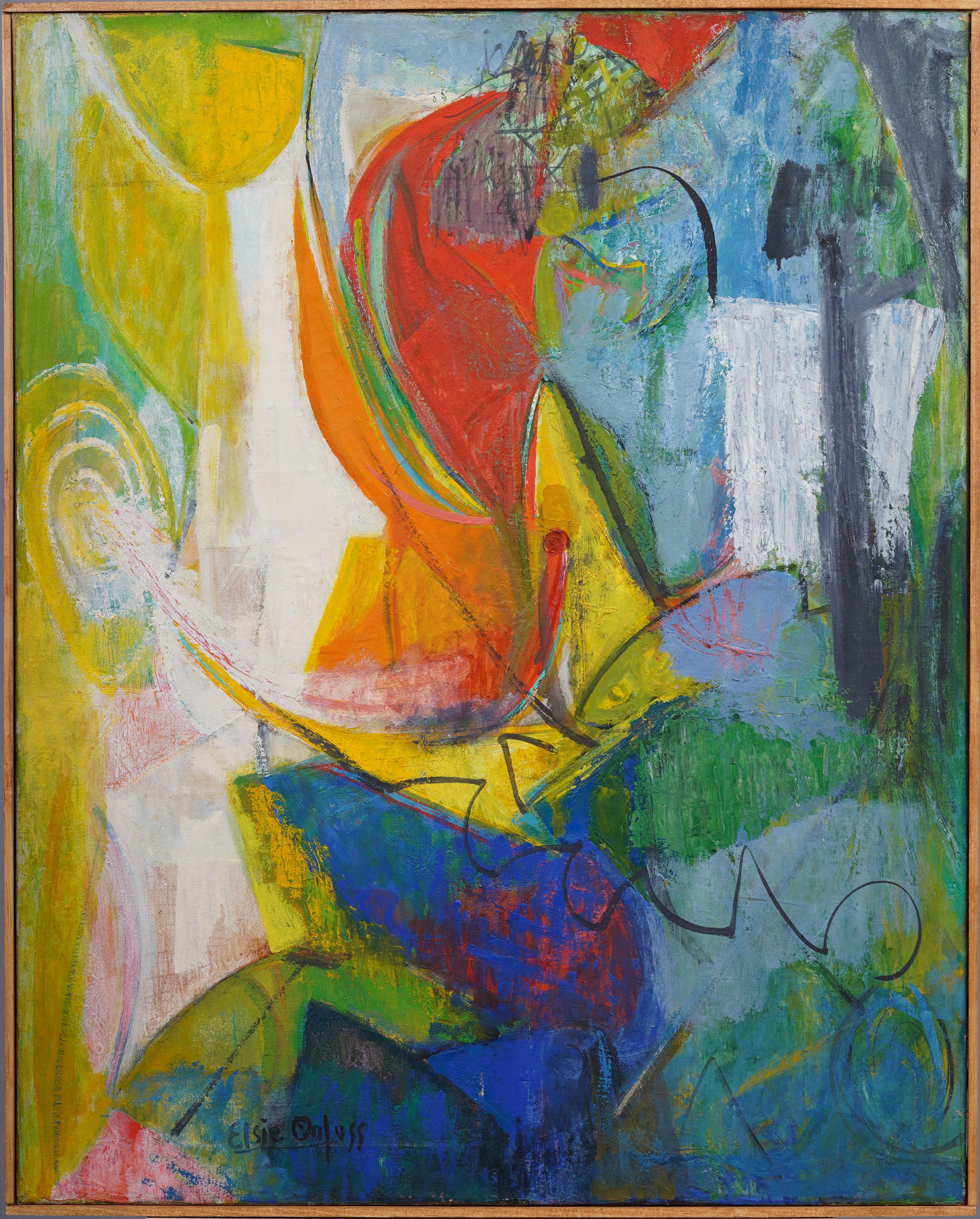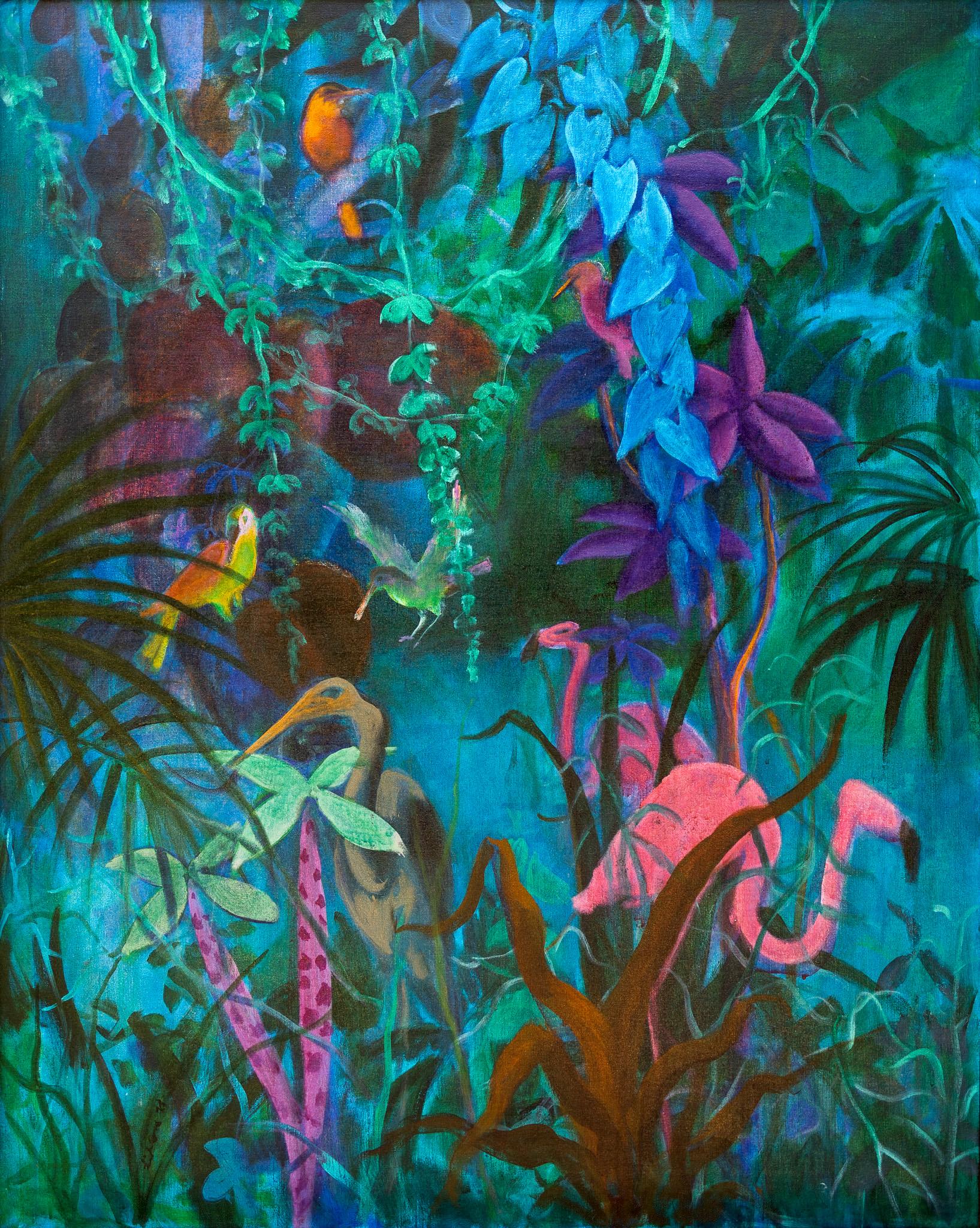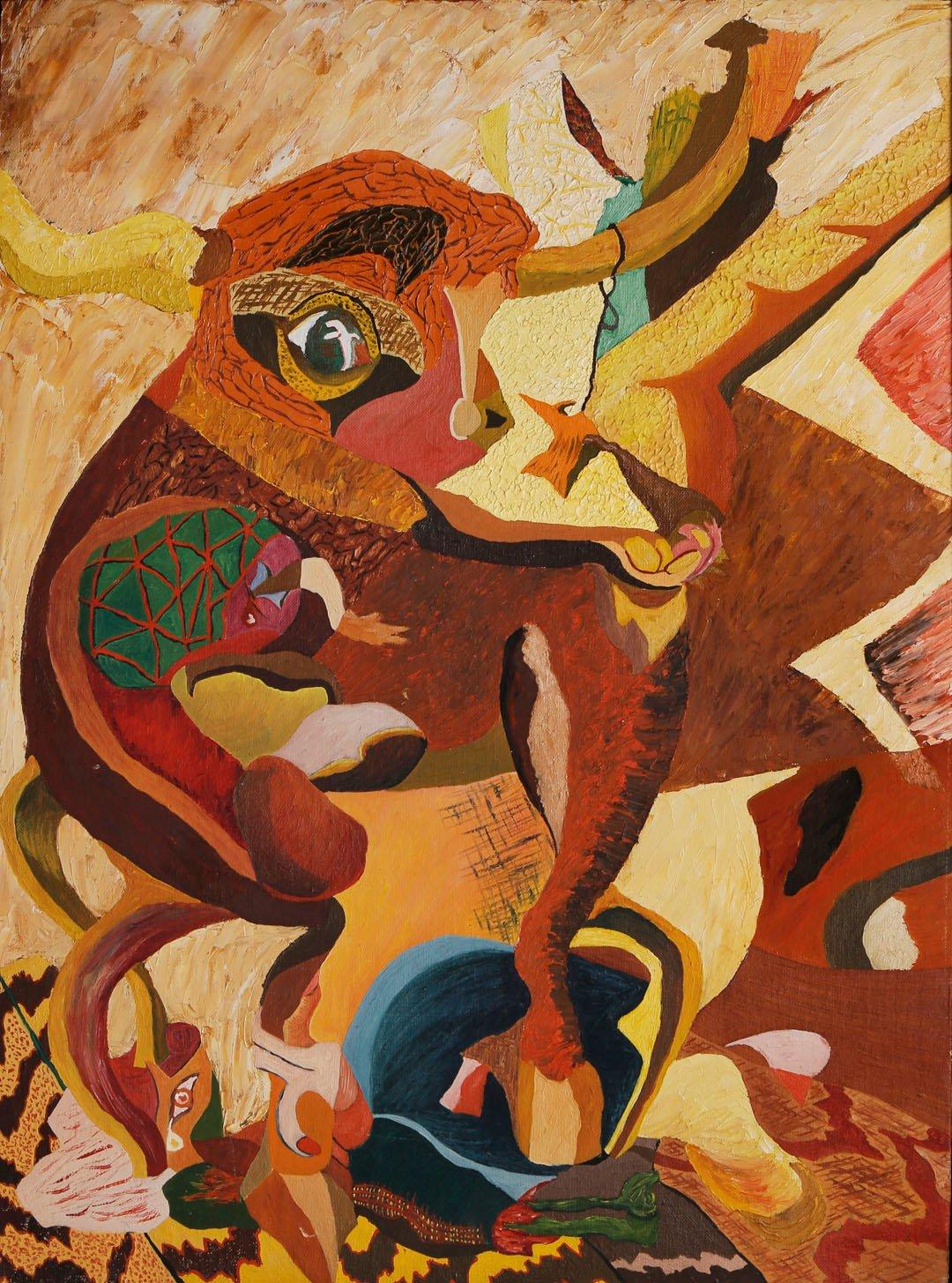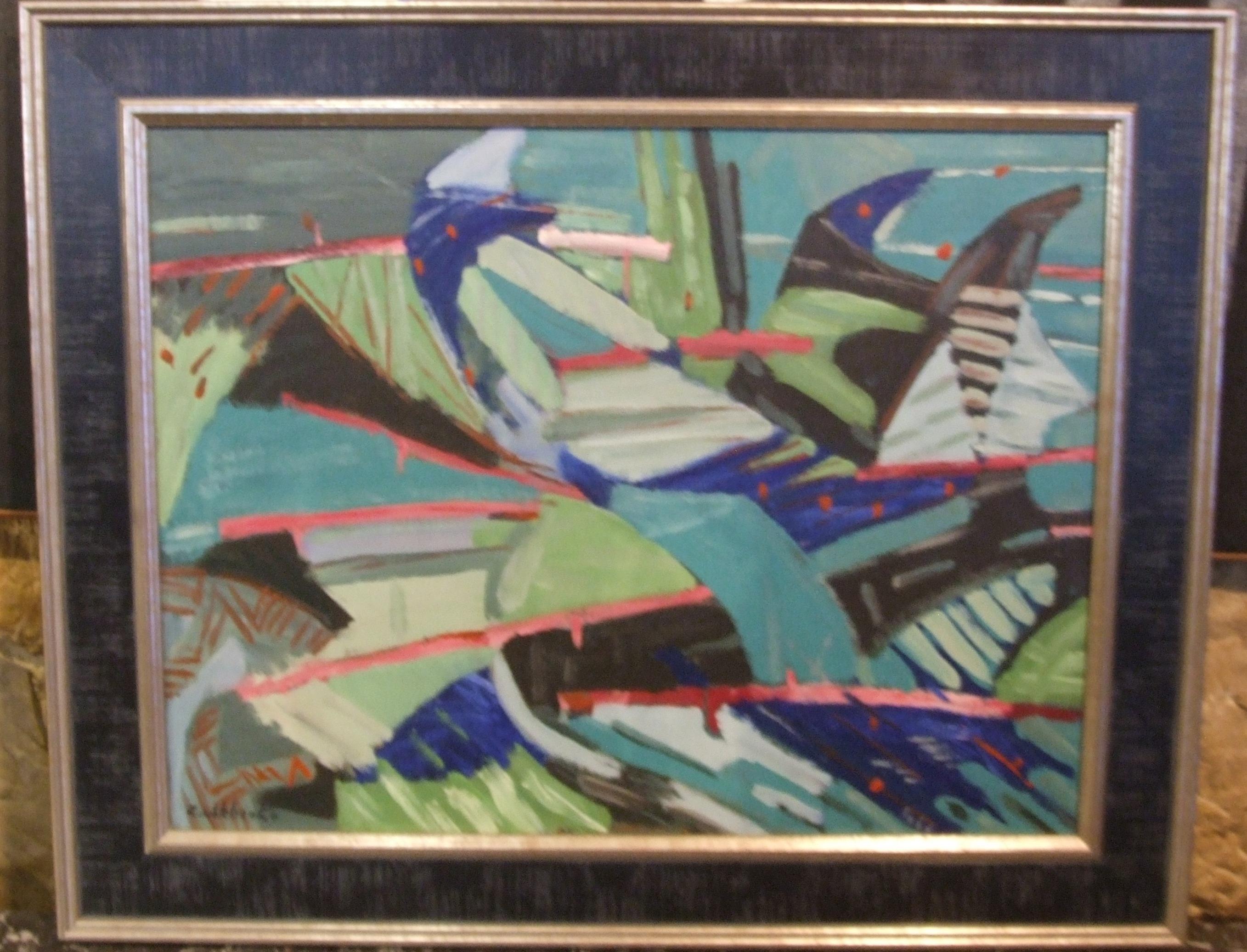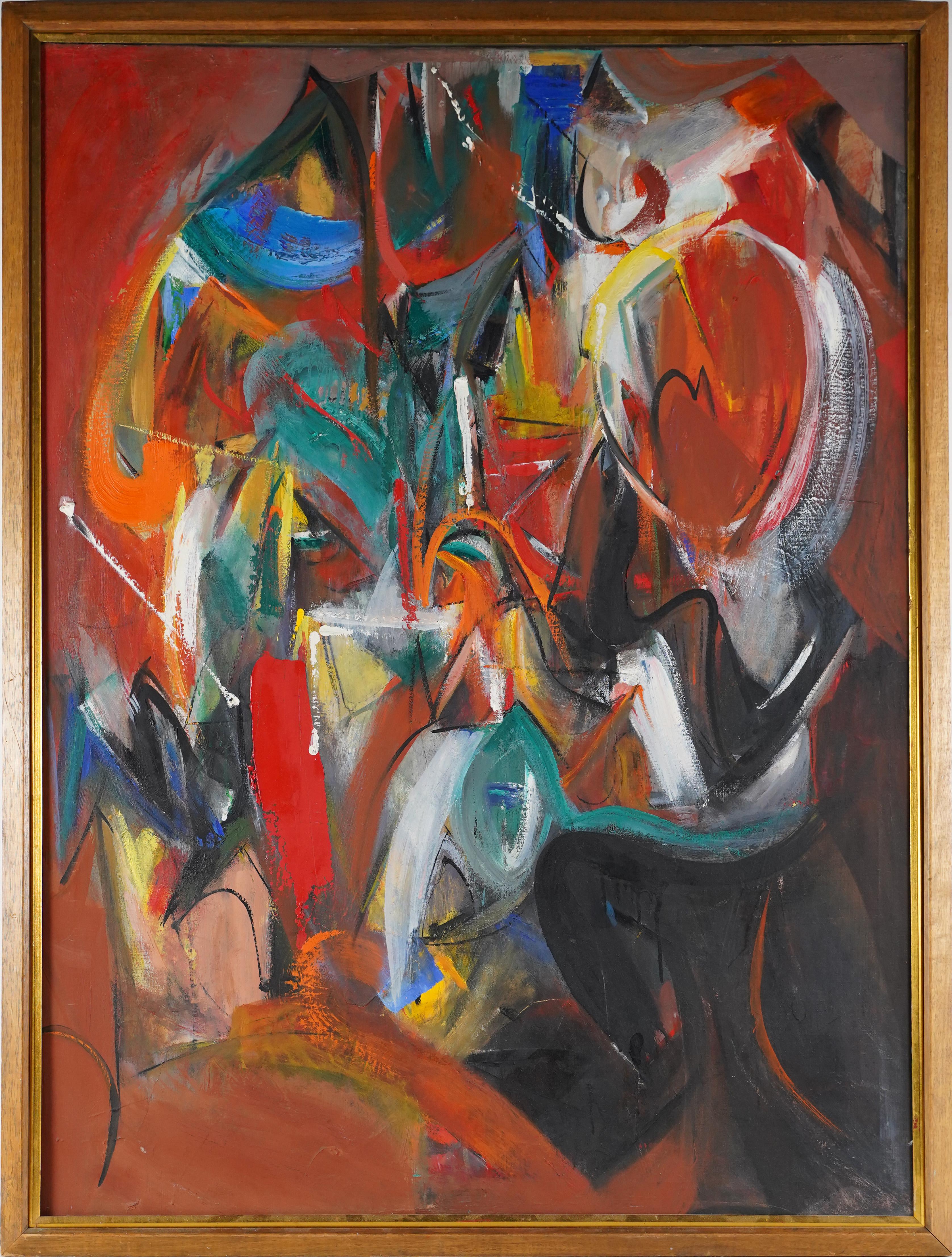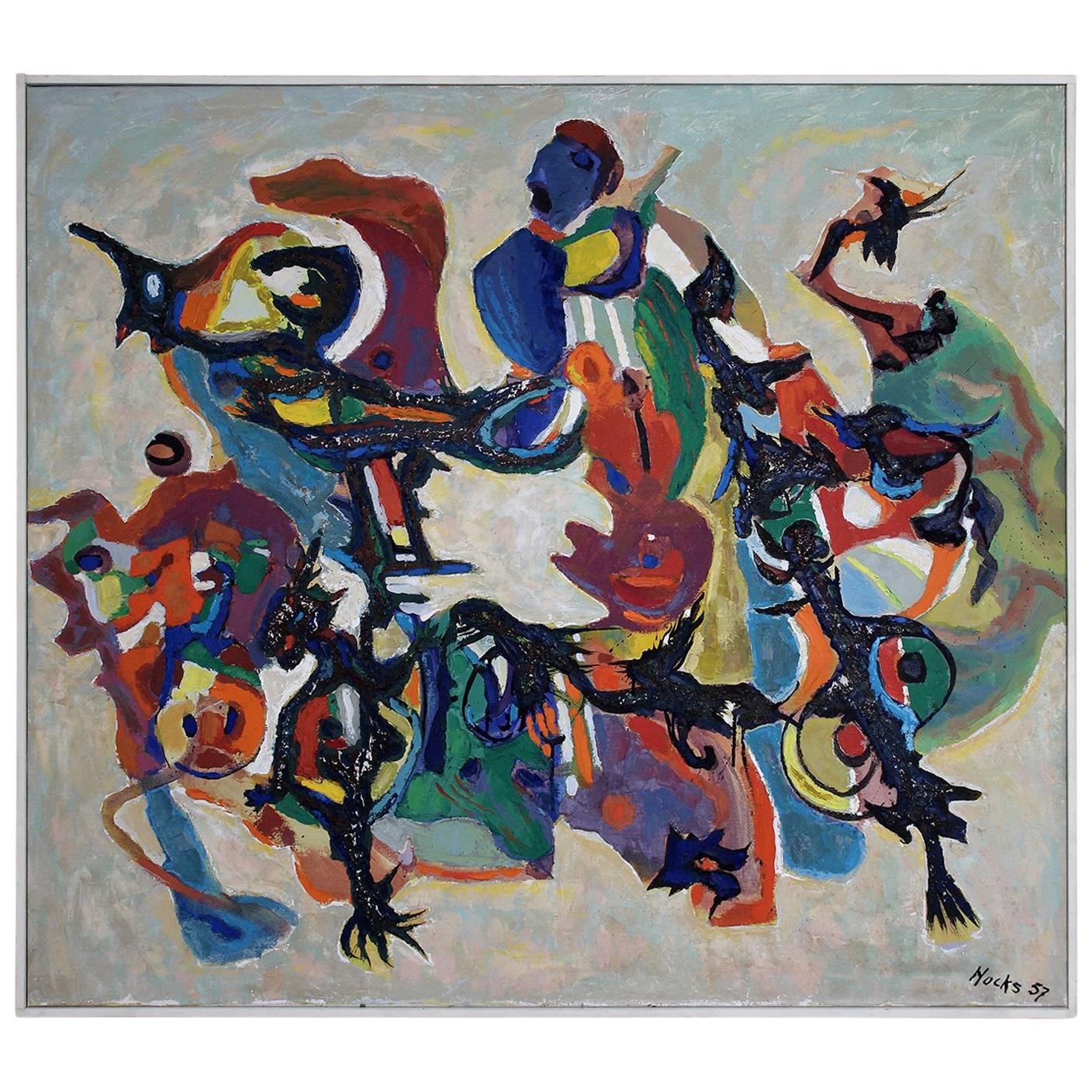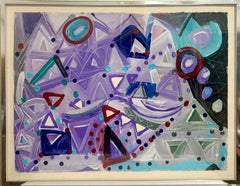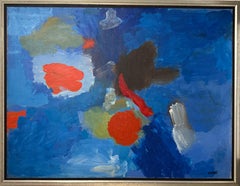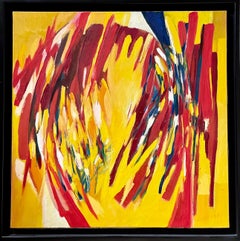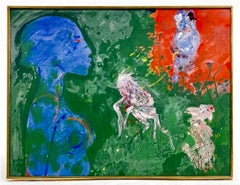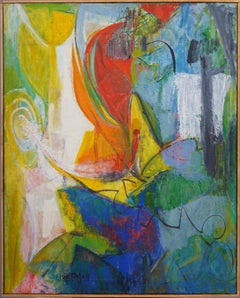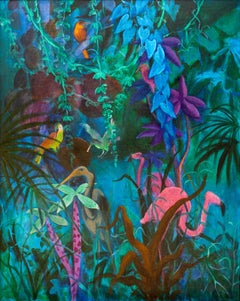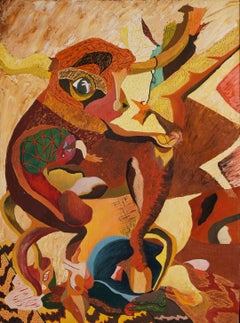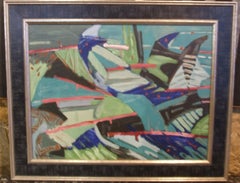Items Similar to Andrene Kauffman Circus or Zoo Abstract Oil Painting Chicago WPA Woman Artist
Want more images or videos?
Request additional images or videos from the seller
1 of 16
Andrene KauffmanAndrene Kauffman Circus or Zoo Abstract Oil Painting Chicago WPA Woman Artistc.1940's
c.1940's
$3,600
£2,707.96
€3,121.37
CA$5,071
A$5,564.09
CHF 2,911.99
MX$68,475.14
NOK 36,686.68
SEK 34,362.54
DKK 23,306.95
About the Item
Andrene Kauffman (American, 1905-1993)
Alter Ego.
Surrealist circus or zoo scene with flying animals on an abstract color saturated background.
Oil on masonite.
Hand signed ANKAU lower left.
Dimensions: 24 x 30”. Frame 25 ½ x 31 ½”.
There is a address label verso from Louise Dunn Yochim She was a well-known artist from Chicago in her time. Louise Yochim was born Luba Dichne in Zhitomir, Russia in 1909. She immigrated to Chicago, along with her parents and four siblings in 1924. Yochim studied at the European Gymnasium and at the Art Institute of Chicago, receiving her Master’s Degree and Doctorate (1962) in Education from the University of Chicago. She was married to notable Chicago artist Maurice Yochim. Yochim exhibited at the Art Institute of Chicago, the Renaissance Society of the University of Chicago, Chicago, IL, the Union League Club, Chicago, IL, the University Club of Chicago, the Cleveland Museum of Art, among others, becoming one of the leading women artists in Chicago. Yochim published three books, the most notable being “Role and Impact: The Chicago Society of Artists”, included in the Illinois Women Artists Project.
Camille Andrene Kauffman (1905 – 1993) was an American painter and educator who created a mural for the post office mural project in Ida Grove, Iowa. She completed twenty-five colorful murals and seven sculptures throughout Chicago, as part of the art projects for the New Deal's Section of Painting and Sculpture. Later, she completed seventeen ceramic murals for the 3rd Unitarian Church, which was designated as a Chicago Landmark in 1960. In addition to her artwork and exhibitions, Kaufman taught art for forty-one years at various universities in Chicago, Rockford, Illinois, and Valparaiso, Indiana. Her work bears the influence of Surrealism and Cubism.
Camille Andrene Kauffmann was born on April 19, 1905, in Chicago, Cook County, Illinois, to Charlotte Camille (née Henriksen) and George Francis Kauffman Kauffman came from an artistic family. Her father was a dress designer and her paternal grandfather, Francis Xavier Kauffman designed furniture. Her brother G. Francis would become a cartoonist and illustrator. She attended Austin Community Academy High School of Chicago before entering the Art Institute of Chicago, graduating in 1926 and winning the John Quincy Adams Fellowship from the Institute for a year of continued study abroad. In 1927, Kauffman went to Paris, where she studied with Andre Lhote and traveled throughout Europe, before returning in 1928 to take up a teaching post at Valparaiso University.
Kauffman was hired as a professor of Painting and drawing at the Art Institute of Chicago upon her return and simultaneously worked instructing art at Valparaiso University. Both assignments were part time and in 1933, when she was approached by the Works Progress Administration (WPA), she joined the federal program. During her time with the WPA, Kauffman produced over 50 easel paintings, 25 murals and 7 sculpture projects earning $24.50 per week. Some of her first works for the WPA were murals painted for the Brookfield Zoo, which was under construction at the time. Between 1936 and 1940, Kauffman painted four murals for the cafeteria of the Emil G. Hirsch Metropolitan High School including Amusement Park, Circus, Rodeo, and Stock Show The murals were painted over with house paint, but the outlines of the canvases are visible on the walls and might be able to be restored In 1937, Kauffman painted Incidents in the Life of Luther Burbank for the Luther Burbank School. The following year, she completed a second mural at the school, Circus. The murals at Burbank were still extant in 2001. The playground houses at Oak Park, Illinois, contain Kaufman's bas relief sculptures depicting fairy tales. These included a cast stone relief based on Thumbelina by Hans Christian Andersen, at the Watts Playground on Hayes Avenue at Division Street; a stone sculpture titled The Cutting of the Cake based on Lewis Carroll's Through the Looking Glass, for the Lincoln Playground at Kenilworth Avenue and Fillmore Street; and a cast stone work Captain Flint based on Robert Louis Stevenson's character at the Pyott Playground on Lake Street at Taylor Avenue. She painted murals at the Cook County Children's Hospital, but they were destroyed when the building was demolished, Kauffman created two bas reliefs for the Lincoln Elementary School in Evanston, Illinois. Children in Fruit Tree and Monkeys are intricate wood carvings with three-dimensional style. In addition, she completed commissions at the Washington School in Evanston and the Lowell School in Oak Park, as well as a mural for the Forest Park Public Library. In 1940, Kauffman won the federal commission to paint Preparation for the First County Fair in Ida Grove–1872 for the post office mural in Ida Grove, Iowa. Many great Chicago artists worked for the WPA including
Rainey Bennett, Charles Turzak, Jean Goodwin Ames, Bernece Berkman, Aaron Bohrod, Edgar Britton, Olga Chassaing, Edouard Chassaing, Mary Anderson Clark, Elizabeth Colwell, ,Gregory Orloff, Paul Robinson, Lester Schwartz, William S. Schwartz, Joseph Vavak and Rudolph Weisenborn. During her time with the WPA project, Kauffman earned her bachelor's degree in Fine Arts in 1939 and completed her Master of Fine Arts in 1941. In 1943, when the WPA project ended, Kauffman resigned her teaching post at Valparaiso University and took a position as an aircraft engineering drafter in a war plant. When the war ended, she returned to teaching, taking a position at Rockford College as the chair of the art department, while still teaching at the Art Institute of Chicago. In 1947, she designed the Jane Addams medal for Rockford to be awarded to students for distinguished service. Taking a sabbatical to study ceramics in 1951 at the Art Institute, she returned as an associate professor to Rockford in 1952. She completed two ceramic murals that year, Deduction and Induction, which were installed on either side of the entrance of the new science building at the university.
In 1955, Kauffman began a series of seventeen murals for the Third Unitarian Church, for which she also designed a large stained glass window, which is the dominant feature of the south wall of the building. The first ceramic tile portrait was of Woodrow Wilson and was unveiled as part of the centennial celebrations for Wilson's birth. The last portrait was of Roger Williams and was completed in 1963.[18] Kauffman retired in 1967 from the Art Institute, but continued working and exhibiting her works. She held a one-woman show at the Vanderpoel Art Gallery in 1971, painted a mural for the Viola Gitzel Memorial Addition to the Forest Park Library in 1972, and was part of a three-artist exhibit at Loyola University in 1985. One of her works was chosen in 1990 from a state-wide competition, to hang in Chicago's State of Illinois Building
Kauffman died on July 4, 1993, in Chicago. Throughout her lifetime, her works were exhibited at the Brooklyn Museum, Riverside Museum and the Whitney Museum of American Art in New York City, as well as at numerous galleries in Chicago. The Third Unitarian Church of Chicago, known as the "church of the murals" because of Kauffman's artwork has been designated a Chicago architectural landmark. Photographs of the murals were displayed in New York and at an exhibit hosted by the U.S. National Society of Mural Painters in Moscow, at the College of Industrial and Applied Arts.
- Creator:Andrene Kauffman (1905 - 1993, American)
- Creation Year:c.1940's
- Dimensions:Height: 25.5 in (64.77 cm)Width: 31.5 in (80.01 cm)
- Medium:
- Period:
- Condition:
- Gallery Location:Surfside, FL
- Reference Number:1stDibs: LU38216610332
About the Seller
4.9
Platinum Seller
Premium sellers with a 4.7+ rating and 24-hour response times
Established in 1995
1stDibs seller since 2014
1,806 sales on 1stDibs
Typical response time: <1 hour
- ShippingRetrieving quote...Shipping from: Miami, FL
- Return Policy
Authenticity Guarantee
In the unlikely event there’s an issue with an item’s authenticity, contact us within 1 year for a full refund. DetailsMoney-Back Guarantee
If your item is not as described, is damaged in transit, or does not arrive, contact us within 7 days for a full refund. Details24-Hour Cancellation
You have a 24-hour grace period in which to reconsider your purchase, with no questions asked.Vetted Professional Sellers
Our world-class sellers must adhere to strict standards for service and quality, maintaining the integrity of our listings.Price-Match Guarantee
If you find that a seller listed the same item for a lower price elsewhere, we’ll match it.Trusted Global Delivery
Our best-in-class carrier network provides specialized shipping options worldwide, including custom delivery.More From This Seller
View AllAbstract Expressionist 1980s Painting Miami Woman Modernist Lynne Golob Gelfman
By Lynne Golob Gelfman
Located in Surfside, FL
Lynne Golob Gelfman, American (1944-2020)
Abstract Composition
Acrylic polymer on paper
Hand signed and dated recto
Sheet: 22 x 30 inches
Frame dimensions: 26 x 33 frame with glazing...
Category
1980s Contemporary Abstract Paintings
Materials
Mixed Media, Acrylic
Large Abstract Expressionist Oil Painting on Canvas John Von Wicht WPA Artist
Located in Surfside, FL
John von Wicht (German American, 1888-1970)
"On Blue"
1964
Oil and acrylic on canvas
Hand signed lower right "V. Wicht",
Hand signed, titled, and dated on the stretcher "1964-66"
D...
Category
1960s Abstract Expressionist Abstract Paintings
Materials
Oil, Canvas, Acrylic
1960's Large Colorful Abstract Expressionist Swiss Oil Painting Robert Lauro
Located in Surfside, FL
Oil Painting on canvas
Hand signed to lower right Lauro.
Provenance: Eleonore Austerer Gallery, San Francisco, CA
Work Size: 39.5 x 39.5 in. framed 44 X 44 inches.
Roberto Lauro is a British-Swiss Post War & Contemporary artist who was born in 1932.
Roberto Lauro was born in 1932 in Gorey Harbor on the island of Jersey (Great Britain) the son of a Swiss mother, Rosa Ramseier, from Oberdiessbach / Emmental, Switzerland, and and Italian father Innocenzo Roberto Lauro, born in Mondovi, Italy. In 1941 he moved to Switzerland with his mother. 1949-1953 he lived in Gunten (Switzerland) where he did an Apprenticeship as a lithograph and offset printer and graphic designer in Thun. There he was introduced to the color theory of Johannes Itten by Hermann Oberli at the Bern School of Applied Arts. From 1953 to 1955 he worked as a fine art printer in Norway where he was influenced by the color theory of Edvard Munch. These works bears the influence of Russian artist Andre Lanskoy, Tachisme and the Cobra artists Karel Appel, Constant, Corneille, Christian Dotremont, Asger Jorn, and Joseph Noiret.
In 1955-1956 he worked as an offset printer in Amsterdam (Netherlands). Visit to the Instituut voor Kunstnijverheidsonderwijs. In 1957 he returned to Gunten, Switzerland. Where he started working in printmaking and and oil painting. He resumed his studies at the Bern School of Applied Arts. He was greatly impacted and influenced by abstract art on the occasion of a large Paul KIee exhibition. In 1958 he moved to Zurich where he worked part-time work as an offset copyist; fulfilling graphic orders for advertising agencies. In 1962 he took his final examination as graphic designer at the Zurich School of Applied Arts. In 1980 he begins his development of three-dimensional picture objects, Sculpture, detachment from the canvas, using metal as a support and play space for light and color. By 1981 he has turned full time to fine art. He spends the next years growing and developing his considerable talent. Inspired by classical music, the rhythm, mood and lightness of which form the basis for the large swings and loops of his colorfully lacquered metal and blown glass sculptures. These are "pensieri", thought sketches that capture the emotions in countless versions. There is something dance-like about his rotating sculptures. Everything becomes music and the rhythm of colors. In 1988, after exhibitions in Europe, he has his first exhibitions in Atlanta and San Francisco (USA), In 1989 he does his first glass and metal sculptures at the Roberto Niederer glassworks, Hergiswil (Switzerland). In 1992 has a retrospective exhibition in the Tan Gallery, Zurich, and the Eleonore Austerer Gallery, San Francisco. They Publish a catalogue raisonne, Eine Retrospektive, covering a 45 year career. In 1993 he creates A Retrospective, a unique sculpture in a table top form that contains his catalogue raisonne and an original lithograph.
1993–1995 he begins work on a number of large scale public outdoor commissions, including Light Columns for a Bank building, and a commission of a sculpture-fountain in Oetwil am See. In 2001 he creates a wall sculpture entitled "Color Poems of the Yearly Cycle. A linen bound book enclosed in a unique plexi display with a one - of a - kind metal and glass sculpture,containing 12 linocuts each printed in colors and signed.
Roberto Lauro's sculptural work work is spontaneous and loaded with energy. The furrows, rifts, cracks and scars in the metal allow light to enter; it is then reflected back by the glass. His work is a clear statement of our times, uniting the intellect and the heart in search of the spiritual. Like the interplay of light and shadow, his sculpture combines fragile, transparent glass with solid, heavy iron. These colorful and luminous sculptures convey a powerful presence and emit vibrant positive energy. With their jagged exteriors and translucent cores, the spectacular sculptures created by the synergy of metal and glass are powerful - yet fragile. Lauro has created and mastered his own idiom and proven that through the artist sheer will and vision, seemingly incompatible materials such as iron and glass can indeed be combined. In 2004 he has an anniversary exhibition Light and Color, Love of Life on the island of birth, Jersey. Ceramic works (raku with glass inclusions). Roberto Lauro's works have been shown in numerous exhibitions in Europe and the USA around the world, and he has also realized projects such as "KUNST AM BAU" in public spaces and for industry. He lives and works in Switzerland.
Select Exhibitions
Eleonore Austerer Gallery, Palm Desert
ART IN THE FRAME FOUNDATION: The Harbour Gallery, Isle of Jersey
Galerie fur Gegenwartskunst,, Bonstetten, Switzerland
Galerie Annamarie Anderson, Zurich, Switzerland
“Color and Light,” Austerer-Crider Gallery, Palm Springs, CA, USA
“Color and Light: the art of Roberto Lauro,” Eleonore Austerer Gallery, San Francisco, CA, USA
“Flower Power,” with Ed Baynard, Roberto Azank, Siegward Sprotte, and Daniel Phil...
Category
1960s Abstract Expressionist Abstract Paintings
Materials
Canvas, Oil
American Neo Expressionist Woman with Monkeys Abstract Modernist Oil Painting
By Robert Beauchamp
Located in Surfside, FL
Robert Beauchamp, American (1923-1995)
Untitled
Hand signed lower right, titled verso.
MIxed media oil painting on heavy art paper
sight: 22 3/4 x 29 1/2 inches
frame dimensions: 23 1/4 x 30 1/4 x 1 1/4 inches, metal frame with glazing
Provenance: Private Collection. Frame inscribed 'Property of AT&T' Bears label from their corporate art collection.
Robert Beauchamp (1923 – March 1995) was an American figurative painter and arts educator. Beauchamp's paintings and drawings are known for depicting dramatic creatures and figures with expressionistic colors. His work was described in the New York Times as being "both frightening and amusing,". He was a Guggenheim Fellow and a student of Hans Hofmann.
Robert Beauchamp was born in Denver, Colorado in 1923. He had three brothers and three sisters, and the children were orphaned by both parents by the time Beauchamp was three. The family grew up impoverished due to the Great Depression, living in a community house with other families. As a child he dabbled in art but it wasn't until high school that he began taking art classes. When not creating art he also played sports; football and basketball, and enjoyed chemistry and geology.
He was told he was good at drawing, and replaced study hall classes with art classes, receiving instruction and inspiration from a Welsh teacher named R. Idris Thomas. While in high school Beauchamp would go, every Monday, to the public library and a local museum where he would read books about art; specifically French painting, as assigned by Thomas. Beauchamp absorbed the tenets of European Modernism and American Abstract Expressionism—with which he eventually broke. While abstraction, with its focus on color and form, underlies his compositions, he filled canvas and paper with psychologically acute portraits of himself and others, nudes, animals, and objects of all kinds. Beauchamp would spend upwards of four hours a day in the art room and eventually won the Carter Memorial Prize, which provided a scholarship to the Colorado Springs Fine Arts Center. At Colorado Springs he studied under Boardman Robinson, painting landscapes in nature.
Beauchamp eventually joined the Navy and then returned to Colorado Springs to continue his studies. Traveling the world as an Armed Guard, he spent a year and a half at sea and the rest of the three years in San Francisco. Seeking to make money, and to follow his love for a girl, Beauchamp decided to attend Cranbrook Academy of Art from 1947–1948. There he studied pottery, believing one could "make more money selling pots than you could selling paintings." He described his experience at Cranbrook as intimidating and claustrophobic, and eventually switched to sculpture before switching to painting.
Beauchamp moved to New York City in the early 1950s and was involved in the Tenth Street galleries, which provided outlets for more experimental artists and the second generation of abstract expressionists. Despite his involvement with 10th Street and friendships with abstract artists, abstract art never interested in him. He showed at numerous galleries in New York and Provincetown, socializing with gallery owners, artists and collectors. His first exhibition was at the Tanager Gallery in New York, he also showed during the 1950s at the Hansa Gallery. In New York and Provincetown he studied under Hans Hofmann Eventually he felt that abstract expressionism became dull and stalemated.
During the 1960s he showed at the Green Gallery. C. 1960 he was awarded a Fulbright Award allowing him to travel to La Romola, Italy. He traveled frequently to cities such as Rome and worked constantly. Beauchamp returned to the states and lived in Provincetown at Walter Gutman...
Category
20th Century Neo-Expressionist Abstract Paintings
Materials
Paper, Oil
Florida Oil Painting African American Woman Art Annie Nobles Miller Indian River
Located in Surfside, FL
"Annie Nobles Miller"
Abstract Florida landscape oil on board painting
Hand signed lower left Inscribed on verso St. Lucie County.
Measures: Board 24"H x 30"W; Framed - 32"H x 38"W.
Annie Miller was a member of the Indian River School of Painting, which was not a formal school but was a group of mostly African-American Florida working class people who wanted to paint. Following is the explanation of that school and its participants. Indian River School is a name applied to Floridian artists in the 1950's and 1960's. They were heavily influenced by nature. Most of the artists in this movement were African American. Their work is characterized by quick strokes and eschews traditional methods of paintings. The main influence for the group was a man named A.E. Backus, a Bohemian white man who mentored the group of young black artists. The group used to congregate in his studio and learnt to paint from 'Beanie' (as he was called) as a way out of their lower class labour jobs. Their work was powerful, dramatic yet captured the serenity and beauty of the Florida
Although the exact count of artists mentored by A.E. Backus remains unknown, experts estimate it to be around 20 individuals, many of whom he supported through college.
Albert Ernest "Beanie" Backus (1906–1990) was famous for his vivid, naturalist Florida landscapes capturing a fast-vanishing Florida wild lands. Backus would come to be seen as the seminal Florida landscape painter, and others who followed would emulate him. Primarily of the Indian River and Everglades areas of Florida. Backus was a Native Floridian artist of great importance recreating scenes of Florida's sky, rivers, ocean, back country, unpredictable weather, clouds, and birds. Born in Fort Pierce, FL to a family of talented boat designers and builders. His "Uncle" Reg Goodwin helped Backus as a young painter go to the Parsons School of Fine Art in New York in 1924. He was referred to as “Florida’s painter laureate,” and the “Dean of Florida’s landscape painters.”In addition to his influence on the Florida Highwaymen painters (Alfred Hair...
Category
1960s Abstract Abstract Paintings
Materials
Oil, Board
Abstract Expressionist 1980s Painting Miami Woman Modernist Lynne Golob Gelfman
By Lynne Golob Gelfman
Located in Surfside, FL
Lynne Golob Gelfman, American (1944-2020)
Abstract Composition
Acrylic polymer on paper
Hand signed and dated recto
Sheet: 22 x 30 inches
Frame dimensions: 26 x 33 frame with glazing...
Category
1980s Contemporary Abstract Paintings
Materials
Mixed Media, Acrylic
You May Also Like
Antique American School Female Artist Abstract Expressionist Cubist Oil Painting
Located in Buffalo, NY
Antique modernist abstract painting by Elsie Orfuss (Born 1913). Oil on canvas. Signed on verso. Nicely framed.
`
Category
1950s Abstract Expressionist Abstract Paintings
Materials
Canvas, Oil
"Birds at the Chicago Zoo" Modernist Nature Scene
Located in Austin, TX
Artist: Gustav Likan
Title: Pond in the Jungle
Size: 50" x 39.5"
Medium: Acrylic on Canvas
Framing: Framed
Condition: Excellent
About the Artist:
Born in Yugoslavia in 1912, Gustav...
Category
Mid-20th Century Fauvist Animal Paintings
Materials
Canvas, Acrylic
20th C. Figurative Abstract Painting Cleveland School African American Artist
By Beni E. Kosh
Located in Beachwood, OH
Beni E. Kosh/Charles Elmer Harris (American, 1917-1993)
Untitled
Oil on canvas board
Estate stamped #611 verso
24 x 18 inches
Charles Elmer Harris was born in 1917 in Cleveland, Oh...
Category
20th Century American Modern Figurative Paintings
Materials
Oil
Abstract Composition 1, '60s - oil paint, 43x56 cm., framed
By Catherine Zoubtchenko
Located in Nice, FR
Born in Leningrad (now Saint-Petersbourg, Russia) in 1937, Catherine Zoubtchenko lives in France since 1945. She was a student of the painter André Lanskoy, with whom she later share...
Category
1960s Abstract Abstract Paintings
Materials
Oil
Antique American School Female Artist Abstract Expressionist Signed Oil Painting
Located in Buffalo, NY
Antique modernist abstract painting by Elsie Orfuss (Born 1913). Oil on canvas. Signed on verso. Nicely framed. Image size, 36L x 48H
Category
1940s Abstract Expressionist Abstract Paintings
Materials
Canvas, Oil
$3,580 Sale Price
20% Off
1957 Fred Hocks Oil on Canvas Abstract Painting
By Fred Hocks
Located in San Diego, CA
Excellent example of a large oil on canvas abstraction by Fred Hocks from 1957. This painting was included in the 1976 retrospective at the Fine Arts Gallery in San Diego which later became the San Diego Museum of Art.
No painter embodies San Diego’s early avant-garde more than Fred (Ferdinand) Hocks, a German-born painter who began visiting San Diego in the late 1920s after studies at the California School of Fine Art in San Francisco and the Art Students League in New York. Fellow painter Dan Dickey credited Hocks in 1947 with “opening up pathways for future, more enlightened generations (of artists),” and predicted that Fred Hocks would be “esteemed a master.”
During the post-war years Hocks was assistant director of the San Diego School of Arts and Crafts, a private art school in La Jolla, and was instrumental in keeping affordable artist’s studios in Spanish Village. Along with modern architect Lloyd Ruocco, Fred Hocks co-founded the dynamic Allied Artists Council with Belle Baranceanu, Everett Gee Jackson, Dan Dickey and John Olsen.
The well-travelled Hocks exhibited in San Francisco, Oakland, Los Angeles, Long Beach, Pasadena, Paris, Mallorca and Guadalajara, had several one-person shows at the Art Center La Jolla/La Jolla Museum of Art and at the Fine Arts Gallery (SDMA). The San Diego Museum of Art held a major retrospective of his painting in 1976, just a few years before his death. He brought a continental element to the local art scene and is described in Bruce Kamerling’s 100 Years of Art in San Diego as “one of the most adventurous local artists…an intelligent and articulate defender of modern tendencies in art.” Local arts and architecture writer James Britton called Fred Hocks “the dean of the San Diego moderns...
Category
Mid-20th Century American Mid-Century Modern Contemporary Art
More Ways To Browse
Used Furniture In Chicago
Mid Century Abstract Cubism Art
Abstract Art 30 X 50
John Andre
Paul Taylor
Fairy Sculpture
Lake George Oil Painting
John Watts
Midcentury European Street Scene Painting
Elizabeth Chair
John Lewis Vintage
Grandfather Chair
Paris Street Scene Painting Large Canvas Painting
Mid Century Painting By Anderson
George Washington Chair
Paris Club Chairs
Oak Tree Oil Painting
Sculpture Chicago
